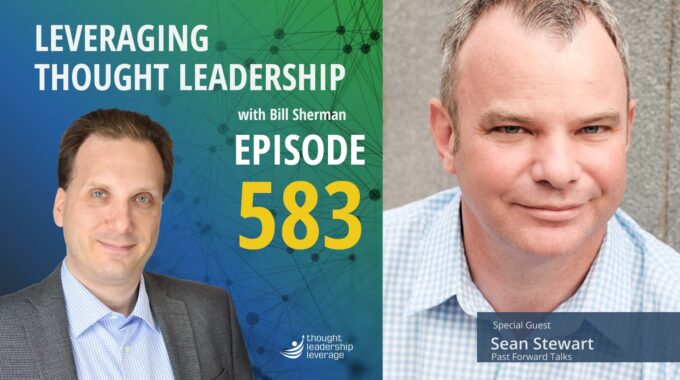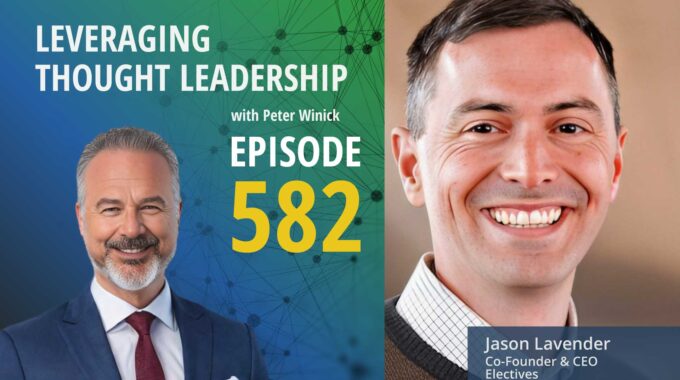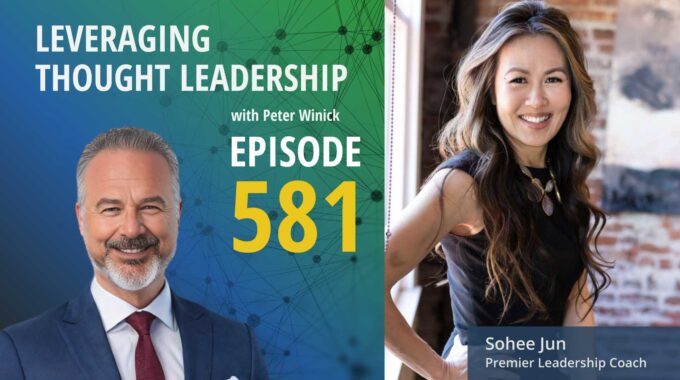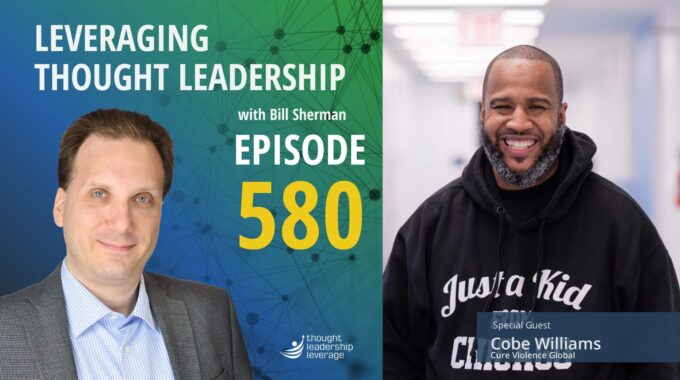Turning Everyday Objects into Tools for Effective Leadership A conversation with Sean Stewart on how…
Best of 2023 featuring Jenna Fisher, Mark Miller, Lily Zheng, and Jane Hanson
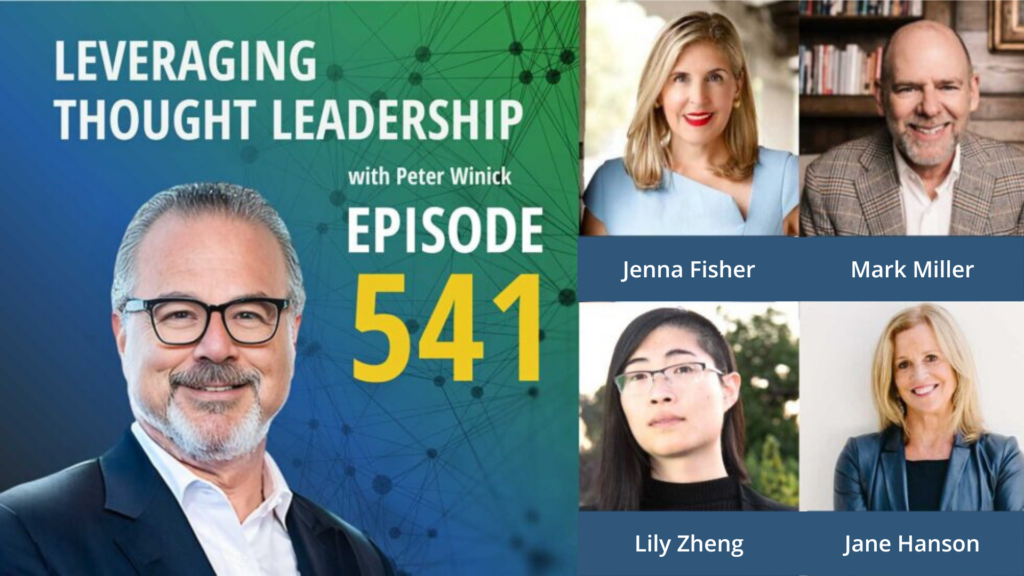
A compilation of some of our best guests in 2023.
Clips from interviews with Jenna Fisher, Mark Miller, Lily Zheng and Jane Hanson.
As we ring in the New Year it is always a good idea to take a moment and reflect on the past year. We continue our tradition of doing so by providing a compilation from a few guests who provided timeless advice.
Jenna Fisher is the Co-lead of Global Financial Officer Practice at Russell Reynolds Associates and a Wall Street Journal bestselling author with a new book To the Top: How Women in Corporate Leadership Are Rewriting the Rules for Success. In this conversation, Jenna shares how she interviewed dozens of women who provided inspirational and practical stories that she used in her book. In addition, she discusses the synergy the book has with her business and what she learned in the process of writing.
Mark Miller is the Vice President of High Performance Leadership, Chick-fil-A Inc. and author of Culture Rules: The Leader’s Guide to Creating the Ultimate Competitive Advantage. Mark gives insight into being an embedded research house within Chick-fil-A and how pragmatism and leadership are the keys to balancing the scales between the two.
Lily Zheng is a Diversity, Equity, and Inclusion speaker, strategist, and organizational consultant. Recently they wrote DEI Deconstructed: Your No-Nonsense Guide to Doing the Work and Doing It Right. Lily discusses the ebb and flow of DEI in the workplace and how it is something that is needed all the time not just when things go wrong.
Jane Hanson is an Emmy Award winning Journalist with thirty years of coaching experience helping people communicate more clearly and efficiently. Jane shares what thought leadership means to her and how the heart of soul of it is communication. She discusses knowing your purpose and provides tips and advice for communicating in mediums you might not excel at.
Three Key Takeaways:
- While doing research for a book or any thought leadership, reaching out to a diverse audience can help give you a wider and more balanced perspective.
- Everything rises and falls with leadership.
- As a thought leader your purpose needs to be getting the important information you have out into the world for others to hear and use.
If you need a strategy to bring your thought leadership to market, Thought Leadership Leverage can assist you! Contact us for more information. In addition, we can help you implement marketing, research, and sales. Let us help you so you can devote yourself to what you do best.

Transcript
Peter Winick My guest is Jenna Ficher. She just wrote a book called To the Top. So before we dive into the essence of the book, what expectations did you have upfront about either what the process would be or whatever, versus the reality of actually writing a book and now doing the hard part? Not that writing’s not hard, but actually getting it out and get eyeballs on the book and get it in the right hands of the right foot. What were the things that played out differently than you might have expected?
Jenna Fisher Yeah, it’s a great question. You know, one of my friends who has been a bestselling author said to me, you know, while writing the book, it’s hard. It’s much like having a baby. And once the book has been birthed and into the come into the world, that’s really when the hard work begins. And I didn’t really believe him. But now that it’s two weeks from publication date, I’m spending a lot of time talking to people about the book, which is so wonderful to get the message out to the world. But I think there might be some truth to that. So that’s a little bit of a surprise.
Peter Winick All right. Well, we’ll hope the book leaves the nest before its 30 and becomes independent and.
Jenna Fisher Back and all.
Peter Winick That. I need to launch it. Yeah, right, right, right, exactly, exactly. So the model that you use, you interviewed a bunch of women, right? So give it give us the high level overview of the gist of the book and then how you went about writing it.
Jenna Fisher Yeah, well, I guess I would just say by way of background, I’ve always had a passion for keeping women on a path to professional success. Starting when I was in college, I wrote my honors thesis on the differential in performance between boys and girls in math and science. And what I learned in that endeavor was that the only statistically significant discrepancy between boys and girls was around their levels of self-confidence, not achievement. And then fast forward a decade to a very different sort of milieu. When I first started working at Russell Reynolds as an executive recruiter and leadership advisor, and I would hear from the women I interviewed, I’m the only one, only one, only one all the time. And so I started convening groups of women board members and CFOs, the two groups of folks that I recruit here and that followership. And then simultaneously, I had the experience countless times where I’d be introduced to an incredibly talented woman who had had stellar academic credentials and had worked in a super hot company, led an IPO, blah, blah, blah. But then she dropped out of the workforce after she’d had her second or third child. Then fast forward a decade, she want to get back in and I was pretty much useless. And it was almost impossible for these women to rejoin the ranks of the working in a financially meaningful way. And this led me to think there has to be a better way, a way to keeping women with a toe, if not entire foot or more in the world of work so that women could ultimately be financially on par with men. And from there, I set out writing this book, interviewing dozens of incredible women, a very heterogeneous group, So different races, ethnicity, locations, functional expertise, industries, ages, and their stories were both incredibly inspirational, but also really pragmatic that others, I think can benefit from and most importantly, that companies can benefit and learn from.
Peter Winick Yeah, so there are a lot of drivers and motivators and goals and such as behind the scenes, why people write books. Some of it’s intrinsic, right? It forces you to get your thinking tired. It was sort of always in you to get out, sort of speak a little bit about the bridging between the intrinsic like this was just fun to do because I can see as we’re talking your lighting up, you probably learned a lot, right? There’s something somewhat selfish in a good way like, wow, I get to talk to a bunch of smart people and learn stuff. Learn more about a subject that I’m passionate about, but also bridge that to the benefit to the business. Because even though you had this free time with COVID, you could have said, I’m going to double down and find more talent, find more clients, buy more, whatever, right? So how does it benefit both you personally, professionally, etc.? And then where do you see it as a tool in the business side of the house?
Jenna Fisher Yeah, well, it was funny because in 2021 I did that as well. It was such a busy time in recruiting, so it wasn’t necessarily the either or that we pretty synergistic actually, because so many of these women were either clients or had been clients or candidates. And so there was a there was some overlap, not 100%, certainly. But, you know, I certainly I’ve always been very reflective about what do I think it takes to be successful professionally. And I of course, I went into this book writing process with my own hypotheses based on my story, but I did learn a lot. And one of the things I’ve always loved about my job in executive search is that no two days are the same, and I’m always meeting amazing people and talking to incredible people and learning. And this was really just an extension of that. And there were a few surprises that came out of it. Like, for example, one of the things I. Didn’t have a sort of a working hypothesis personally, but that I learned by interviewing these women is the importance of entrepreneurship and how critical that is as sort of a long term wealth creating, multigenerational wealth creating mechanism. And I learned that only 2% of VC deals fund women backed companies. And I’ve definitely seen this play out as a recruiter where women, when I call them about job opportunities, they say, well, I haven’t checked this box or that box, so, you know, you shouldn’t consider me for that role. And it’s the same thing with entrepreneurship. Some of the women I interviewed, like one of the ones that comes to mind is Jennifer Goldfarb, who was the CEO and founder of IPSE, which is an online beauty company, very successful. She said, you know, like I could have always said, like, oh, yeah, there’s another box to check, but at some point you just got to jump in and do it. And, and so yeah, I learned a lot and there certainly were lots of surprises along the way.
Peter Winick My guest is Mark Miller. He is the vice president of High Performance Leadership at Chick fil A. You’re not a consultant to an advisor, an academic thinking, theoretical, great thoughts on culture. I mean, there’s a lot of moving parts to your business, right?
Mark Miller Right.
Peter Winick So this is really. The Chick-Fil-A culture. But more importantly, it’s sort of what can I learn from it, right?
Mark Miller Well, no, actually, not with most all of the projects, probably 90% of the projects. We try to start with what is universally true about a topic. So in the case of culture rules, we ended up surveying or interviewing over 6000 people in ten countries, leaders and frontline associates. And so we’re saying, let’s start with what’s true. I never want to be the guy that just publishes my personal bias. I want something that I can tell a leader all over the world. This will work. I want something I can tell the church, the school, the hospital, the military, the chicken restaurant. I want to try to write about what is universally true. And so our process for many, many years has been let’s try to start there as as much as we possibly can.
Peter Winick So, in essence, you’re not. So simply put it this way, and I’ve seen several, whether it’s culture books, literature, books, whatever, that are the codification of the way we do it here. Wherever. Here. Right, Right the way What?
Mark Miller Yeah, yeah, yeah.
Peter Winick Right. And that’s. That’s a fine model. Hey, we’re known for our leadership. Excellent. Our management excellence. Whatever. Whatever. Let’s share it with the world. You’re almost a sort of an embedded research house in a fast food restaurant coming up with great things, like how does the business justify that? Right? Because at the end of the day, like, how does how does that all square? Because that’s a that’s interesting.
Mark Miller I think it squares because we believe everything rises and falls on leadership. Right. And if we can help our leaders grow their capacity, grow their impact, grow their influence, everybody wins. If we can help them better with execution, better with engagement, better with teams, better building a high performance culture, build better build up. And so those are some of the projects we’ve done over the years. And I would argue there’s a huge ROI on each and every one up.
Peter Winick Well, that’s where I was going to go. I would agree with all of those. But most companies, even those that are, you know, five, ten, 20 exercise talk a good game, but they’re not investing and really having that embedded thought leadership research and development arm inside because again you didn’t codify what we did here. You went out to the world and I mean this is this is classic research classes you know sort of an academic model. So how does the business measure the impact on the ROI that you’re having on it?
Mark Miller Well, let me let me back up. Yeah, there is there is a an academic component. Yes, but it is it is filtered extensively through a pragmatic. Lands and filter. I mean, you made the comment earlier, you know, I have functional responsibilities and have for over 40 years we’re running a business and then trying to help our operators run 3000 businesses. And so somebody told me recently, and I’m not sure if this is good or bad, I probably should repeat this, They said that my personal brand is you are painfully pragmatic. And I said, Well, thank you, I think. Right. If leaders can’t approach the truth, if leaders can’t apply the truth, if it doesn’t work, then everybody loses. And so.
Peter Winick I think painfully pragmatic is the highest level of a compliment.
Mark Miller Well, I told him, I said.
Peter Winick I could say to you, Mark, you’re painfully academic. I don’t need the academic word. That just means you’re painful.
Mark Miller He said, Well, again, I’m thankful. And I kind of wear that proudly because, yes, the stuff has to work.
Peter Winick Mm hmm.
The stuff has to work. And that’s on this project. I’ll give you just a bit of a tangent here. Culture is big and culture is complicated and culture is hard. You go to talk to 6000 people around the world in ten countries, and you’re going to have mountains of data. And then we did all of these interviews with probably 40 or 50 household brands from around the world. One on one interview, I mean, it was crazy and we were overwhelmed and we said, this is not going to help people. And we actually took inspiration from the SEALs, the Navy SEALs. And you might know this your listeners might know this a few years back. They wanted to document in writing their mantra, and the first thing they wrote down was Shoot, Move. Communicate. And the CEOs would tell you that’s not all you need to be a single, but that’s what you need to live to fight another day. And we then said, okay, let’s take all this research and let’s look for the equivalent of shoot, move and communicate, because it’s actionable. It’s it provides direction, it provides clarity. And it’s not all you need to know, but it’ll help you get through the day. And so that was actually what we tried to do. That’s back to that pragmatism. Is this approachable? Is this applicable? And that’s kind of been our charge and challenge.
Peter Winick So again, if you’re enjoying this episode of leveraging thought leadership, please make sure to subscribe. If you’d like to help spread the word about our podcast, please leave a five-star review at rate this podcast.com/ltl and share it with your friends. We’re available on Apple Podcasts and on all major listening apps as well as that thought leadership leverage.com/podcast.
Peter Winick Today my guest is Lily Zheng. Lily is a sought after diversity equity and inclusion speaker, strategist and organizational consultant. In my work with authors, thought leaders, experts, etc. there’s always an evergreen element to their work and what they do. That is true regardless of what happened in the newspaper today or the stock market went up, or it’s the Great Recession or whatever. But then there’s things that happen outside of their control that oftentimes will make their work more in demand, more intriguing or less so in some cases. And I actually falls into that bucket where there’s lots of things going on outside of your control that are making more and more people lean in, going, I don’t think we’re doing this right here. Or what you’ve been feeding us in the past is pretty, pretty terrible or not effective. So give me just maybe touch on that for a moment, if you would.
Lily Zheng Absolutely. So, you know, the analogy that comes to mind is, you know, how you know how tsunamis work, where right before the big giant wave hits, all the water recedes and goes away. Right. So you see the seabed and then, of course, the tourists walk in and go like, oh, that’s the starfish. And then they get hit in the face with the 20 mile wave. Right now, it feels to me like, why is that? But all the time, every week, really, I say that because, you know, we can go back through the last few years and there are so many examples. Talk about COVID. When COVID happened, what was the first thing companies do? They slashed their budgets, they ended their trainings, they closed their contracts. Right. There was just like, oh, we’re going to focus on the real stuff now, right? Not the fancy fun nice to haves where we’re going to focus on the need to have. And then what happened in 2020, the murder of George Floyd.
Peter Winick Exactly. Who?
Lily Zheng Tsunami wave. Right. Suddenly everyone was saying, where are the DTI practitioners? We laid off. Come back, please help, Please help. Now, this happened so many times. It happened when the Trump administration banned DTI trainings and then the surge back. Right. Every single time there’s a, you know, race motivated police killing, DTI surges. Every time there’s a hate crime against Asians, DTI surges every time there’s a new report, every time there’s a new finding on discrimination against women, on disabled folks for queer and trans folks, right? Like our industry is defined almost by this sort of constant push and pull of corporations saying, Well, we don’t need that. That’s just fluffy. Nice to have. And then the world reminding everyone, Oh, yes, absolutely. We need this stuff. Right? We’d we even just started seeing it in the last couple of weeks. Again, companies are saying, well, a recession is coming. Yeah, but what are we going to do? We’re going to cut our DTI budgets. And it doesn’t mean it.
Peter Winick Is largely not largely, but a lot of it is optics because there’s a fear that a company can’t say, oh, look at all the lovely things that we’re doing, whether they’re actually impactful or not. And I think and maybe this is where you’re going, we’re now moving into this different level of DNI where it’s like, you know, and your interest. But it’s about the outcomes.
Lily Zheng Yes.
Peter Winick Right. Not about teaching people that look like acts that they have to hire, people that don’t look like acts like that compliance training from the 1978 that has stuck around because it’s cheap, it’s cost effective. Nobody cared. Nobody was getting in trouble. But how do you make the connection to it being a strategic business driver? Because that’s where you get attention, right?
Lily Zheng Ab- Absolutely.
Peter Winick Compliance and regulatory and all that sort of fun stuff.
Lily Zheng Right. So like I’ve been mentioning, DIY has been very trend driven over the last few years. And I think that’s a major weakness of it because what we want to be doing is consistent long term work that drives consistent long term impact, right? And every piece of research we see says that the short term flashy initiatives just failed are a waste of time. They’re a waste of money. They’re a waste of people’s patience. Right. And so what we need to be doing and there’s research that supports this from the business literature, there’s research that supports this from the sort of critical theory literature is we need to be engaged in these long term efforts to shift workplaces towards greater equity, greater inclusion, and, yes, greater diversity. And we haven’t been doing that because, I mean, hard work is hard, right? Unfortunately, it’s the biggest truism of the world and all work worth doing is difficult. But companies don’t want that right. A lot of leaders I talked to are frustrated. They’re just saying we’re getting bad press. We need to do something quick. We can do something immediately. We need to bring in a practitioner.
Peter Winick Eliminate the hack. Right. We let you know if you were to write an article five Things to Do for Every CEO to cure their DI.
Lily Zheng Oh, I could get it published tomorrow if I want to do that. Yeah.
Peter Winick Yeah. Right. But to actually do the work and change the way we think and the way we behave and the way we believe in the systems, processes, etc. is much harder.
Peter Winick Today. My guest is Jane Hanson, and Jane is an Emmy Award winning television journalist and a coach, and she has spent over 30 years helping people learn to communicate. So a lot of people think thought leadership and they get a little bit overwhelmed. Oh, my God, I’ve got to write an article. Oh, my God. I’ve got to write a book. But you’ll it’s a heavy lift, right? It’s almost like, you know, if you started to work out and the first thing that you did was a marathon, it’s going to be exhausting and overwhelming. But I think that there’s lots of opportunity to use thought leadership in terms of talking points, bullet points, conversations, etc.. So maybe connect the thread of your work in mine of sort of how do you use thought leadership and communicate that effectively in a natural way?
Jane Hanson Well, thought leadership and leadership doesn’t magically happen because one day you say, I think I’m going to be one. Thought leadership is it’s building upon who and what you are. And I believe that the heart and soul of it is good communication, because I I’ve talked to a lot of people that are called thought leaders in whatever expertise theory, and we discussed how did you get to that place where you’re considered the woman, the man, the expert, right to a person. They say it has nothing to do with me aiming to become something. It’s just that I got really good at telling this story and doing it in a way that has confidence and yet knowledge and all of that put into a place and we might call it wisdom.
Peter Winick True. But you could but stay there a minute, because I think there are some folks that are that are really awesome, amazing, wise thought leaders. But because for whatever reason, they’re researchers, they’re academics, they’re introvert, whatever the reason is, and it doesn’t matter that they communicate best via words on a page, right? They write really well, they research really well, but then you ask them to bring it to life, either conversationally, something like this on a podcast or or keynote. And they’re awful, right? It’s just not who they are or what they’re about or those muscles aren’t developed.
Jane Hanson It’s interesting. You know who Simon Sinek is?
Peter Winick Yes.
Jane Hanson Simon has got billions of viewers of his YouTube videos. He’s considered to be one of the best communicators in the world, but he has been known to say that he’s a total introvert, and if he’s at your party, you’ll be the guy sitting over in the corner waiting for somebody to come to talk to him.
Peter Winick Sure.
Jane Hanson So here’s the thing is that in our world today, people don’t take a long time to read a white paper or to read.
Peter Winick Anything.
Jane Hanson Or to read anything. I can’t tell you the number of authors I’ve interviewed who will ask them and say something like, You know, I don’t understand what you mean. On page 64, when you said this and the go, you actually read the book and they’re out there, they’re on a speaking tour all over the country, and I’m like, the first person they’ve encountered that’s actually worth so and that has to do with attention spans, which on average in the United States today are 8 seconds. And we’ve got this this overstimulated world with the social media and with everything being so immediate and so quick. So if, you know, first of all, you got to think, what’s the purpose behind becoming a thought leader? And if your purpose is really. True. It’s about taking the information that you have and getting it out into the world because there’s an importance to it, there’s a significance, there’s a need for it. Know if you’re a researcher and you’ve got something that’s got amazing information about a medical process or a tablet, then you got to get it out there. But if you can’t communicate it, then it’s going to sit where it is and nobody will ever know. And we’re missing out on an opportunity to cure a disease or something.
Peter Winick What are some of the. Tips, suggestions, advice, whatever you might have for someone that is really good at communicating. For example, in the written word. But when they bring it to life conversationally or, you know, public speaking or whatever, it’s just not their thing.
Jane Hanson I recently worked with a woman who wrote a book and she was about to go on a tour and scared to death. And she said, I’ve never spoken in public before. I’ve never done a video. I’ve never been in front of a microphone. I’ve never been in front of lights. I’ve never talked to a reporter. And she goes, I am absolutely scared to death. What do I do? And I said, We’re going to start really simply. And the first thing we’re going to do is you have a lot of information in your book, which I had a book about medicine and women and that sort of thing. I said, So first we need to think about who you want to reach. And she said, My book is really about helping women manage their health. I said, Bingo, That’s where we start. So the first thing we did is help her create really good messages that she could repeat over and over and over again that she got truly comfortable with.
Peter Winick Saying that repetition gives them the comfort to then build on it. And so it’s kind of baby steps.
Jane Hanson And by the way, 87% of the people in this country suffer from something called claustrophobia at one point in their life, which is the fear of public speaking.
Peter Winick Right. Right.
Jane Hanson So a person like this woman I worked with thinks that she’s alone in this feeling. But the.
Peter Winick Only one. Right?
Jane Hanson Right. But she is not at all. Most of us have it at some point in her life. And if we don’t, maybe we’re dead, you know, because there’s going to be a situation. There’s always something happening. Maybe you get up to give a speech and the mic doesn’t work or you blank out or you get really nervous or you’re in a video situation and the tech goes down or you do it right. I mean, all kinds of crap can happen. And so there’s a lot of things that you can be afraid of, but if you stick to your purpose. So my work with her was a really creating some solid messages that she could then repeat over and over with. Because this isn’t it’s not brain surgery. You could if you’re if you’re out there talking about a book, the message is consistently going to be the same. It’s the audience that you And when you.
Peter Winick To learn more about Thought Leadership Leverage, please visit our Web site at thoughtleadershipleverage/com to reach me directly. Feel free to email me at Peter at thoughtleadershipleverage.com and please subscribe to leveraging thought leadership on iTunes or your favorite podcast app to get your weekly episode automatically.


